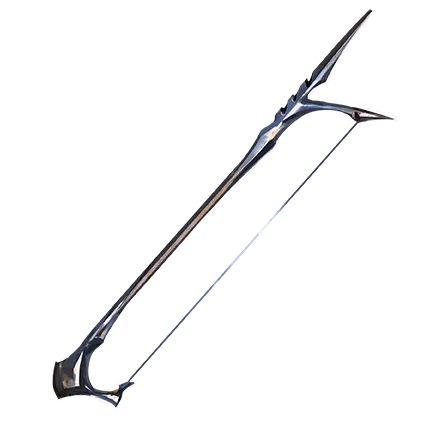
Bow StaffLegacy Content
 CombinationSource Treasure Vault pg. 31 1.1Price
CombinationSource Treasure Vault pg. 31 1.1Price 8 gp;
Bulk 1
Category Martial
The bow staff is a
whipstaff with a retracting spool of wire inside a metal cap on one end and a hooked protrusion on the other. A wielder trained in the weapon's use can quickly spool and attach or detach the wire to transition the weapon between bow and staff functionality.
Melee
FinesseMonkParrySweepDamage 1d6 B
Hands 2
Group Club Ranged
Deadly d8MonkDamage 1d6 P
Hands 1+
Range 80 ft.;
Reload 0
Group BowAmmunition ArrowsTraits
Combination: Combination weapons combine the functionality of melee weapons and ranged weapons in unique or unusual ways. A combination weapon has a ranged form or usage and a melee weapon form or usage. The combination weapons table lists the ranged weapon statistics first and the melee weapon statistics indented beneath, just above the ammunition. Switching between the melee weapon usage and the ranged weapon usage requires an Interact action. However, if your last action was a successful melee Strike against a foe using a combination weapon, you can make a ranged Strike with the combination weapon against that foe without fully switching to the ranged weapon usage, firing the ranged weapon just as you hit with the melee attack. In this case, the combination weapon returns to its melee usage after the ranged weapon Strike.
Since a combination weapon is one weapon with two usages, both usages share any fundamental runes. You can put a property rune on a combination weapon as long as it's appropriate for either of the two usages, but if only one of the usages meets the property rune's requirements, the effects of the property rune only apply for that usage. For instance, a vorpal axe musket only applies the vorpal property rune when you're using it as an axe. Due to their complexity, combination weapons can't have another weapon, such as a bayonet or reinforced stock, attached to them.
Deadly d8: On a critical hit, the weapon adds a weapon damage die of the listed size. Roll this after doubling the weapon's damage. This increases to two dice if the weapon has a greater striking rune and three dice if the weapon has a major striking rune. For instance, a rapier with a greater striking rune deals 2d8 extra piercing damage on a critical hit. An ability that changes the size of the weapon's normal damage dice doesn't change the size of its deadly die.
Finesse: You can use your Dexterity modifier instead of your Strength modifier on attack rolls using this melee weapon. You still use your Strength modifier when calculating damage.
Monk: Abilities with this trait are from the monk class. A weapon with this trait is primarily used by monks.
Monk: Abilities with this trait are from the monk class. A weapon with this trait is primarily used by monks.
Parry: This weapon can be used defensively to block attacks. While wielding this weapon, if your proficiency with it is trained or better, you can spend a single action to position your weapon defensively, gaining a +1 circumstance bonus to AC until the start of your next turn.
Sweep: This weapon makes wide sweeping or spinning attacks, making it easier to attack multiple enemies. When you attack with this weapon, you gain a +1 circumstance bonus to your attack roll if you already attempted to attack a different target this turn using this weapon.
Critical Specialization Effects
Source Core Rulebook pg. 283 4.0Certain feats, class features, weapon runes, and other effects can grant you additional benefits when you make a Strike with certain weapons and get a critical success. This is called a critical specialization effect. The exact effect depends on which weapon group your weapon belongs to, as listed below. You can always decide not to add the critical specialization effect of your weapon.
Bow: If the target of the critical hit is adjacent to a surface, it gets stuck to that surface by the missile. The target is
immobilized and must spend an Interact action to attempt a DC 10
Athletics check to pull the missile free; it can't move from its space until it succeeds. The creature doesn't become stuck if it is incorporeal, is liquid (like a
water elemental or some
oozes), or could otherwise escape without effort.